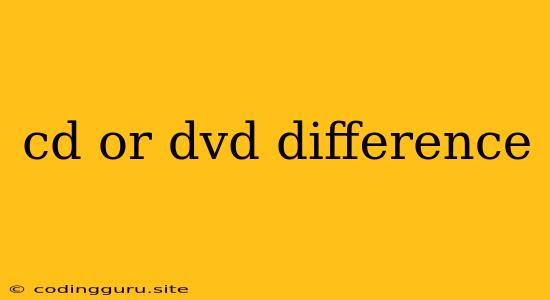CD or DVD: What's the Difference?
In the world of digital storage, CDs and DVDs have been ubiquitous for years, offering convenient ways to store and share data. However, with the advent of newer technologies like USB drives and cloud storage, these optical discs may seem outdated. Despite this, CDs and DVDs still have their place, especially when it comes to archiving and distributing certain types of content. But for many people, the distinction between the two remains a bit unclear.
What exactly is the difference between a CD and a DVD?
Size and Capacity:
The most fundamental difference lies in their size and capacity.
- CDs are smaller, measuring 120 mm in diameter, and have a storage capacity of 700 MB.
- DVDs, on the other hand, are slightly larger at 120 mm and have a storage capacity of 4.7 GB.
This increased capacity for DVDs allows them to hold significantly more data, making them ideal for storing larger files like movies, video games, and software applications.
Data Storage:
While both CDs and DVDs utilize a laser to read data, they employ different techniques for storing information.
- CDs use a single layer of data storage, meaning the data is written on a single side of the disc.
- DVDs can utilize both single and dual layers, allowing for more storage capacity. Dual-layer DVDs can reach up to 8.5 GB of storage.
Data Transfer Rate:
Due to their technological differences, CDs and DVDs also have different data transfer rates.
- CDs have a slower transfer rate, typically around 150 KB/s.
- DVDs have a faster transfer rate, reaching up to 11 MB/s.
This difference in speed is noticeable when reading or writing data, especially for large files.
Types of CDs and DVDs:
There are several different types of CDs and DVDs, each tailored to specific purposes.
Types of CDs:
- CD-R: A recordable CD that allows you to write data once and then read it multiple times.
- CD-RW: A rewritable CD that lets you write and erase data multiple times.
- CD-ROM: A read-only CD that contains pre-recorded data, such as music or software.
Types of DVDs:
- DVD-R: A recordable DVD that allows you to write data once and then read it multiple times.
- DVD-RW: A rewritable DVD that lets you write and erase data multiple times.
- DVD-ROM: A read-only DVD that contains pre-recorded data, such as movies or games.
- DVD+R: A recordable DVD similar to DVD-R.
- DVD+RW: A rewritable DVD similar to DVD-RW.
- DVD-RAM: A rewritable DVD that uses a different technology for writing and erasing data compared to DVD-RW.
Compatibility:
While both CDs and DVDs are read using laser technology, they are not always compatible with all devices.
- Most DVD drives can read CDs, but not all CD drives can read DVDs.
- Some older devices may not be able to read newer formats of CDs and DVDs, such as DVD-RAM.
Durability and Longevity:
The durability and longevity of CDs and DVDs can vary depending on several factors, including the quality of the disc and the storage conditions.
- CDs are generally more susceptible to scratches and damage than DVDs due to their thinner construction.
- Exposure to heat, moisture, and direct sunlight can also affect their lifespan.
Conclusion:
While CDs and DVDs are still used in some applications, the advent of newer technologies like USB drives and cloud storage has diminished their overall popularity. However, their benefits in terms of portability and physical storage remain valuable for certain purposes.
- CDs are still widely used for storing music, data backups, and archival purposes.
- DVDs are favored for storing larger files like movies, video games, and software applications.
Ultimately, choosing between a CD or DVD depends on your specific needs and preferences.
